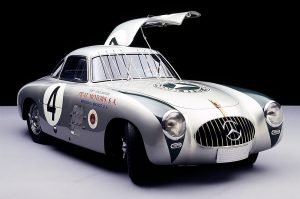
The Mercedes-Benz 300 SL racing sports car, W 194 series (1952-1953)
1 The first racing car from Mercedes-Benz after the Second World War
2 Combination of series-production technology and innovative lightweight build
3 Racing as a coupé and as a roadster
4 1953 racing sports car prototype shows elements of the production sports car
Motor sports as initial fuse
Mercedes-Benz 300 SL was the designation of the competition race car from Mercedes-Benz with which the brand returned to international motor sports in 1952 for the first time after the Second World War. And although this car was not sold to the public, it did light the fuse for the development of the later SL-Class from Mercedes-Benz. The development of the 300 SL began in 1950, when Mercedes-Benz began to think about a return to racing. The attempt to reactivate the 1939 W 154 Grand Prix race car, however, met with failure in Argentina in 1951. So engineers pressed forward the development of the new racing car, some of the components of which came from the Mercedes-Benz 300.
In June 1951, the Board decided to resume participation in racing events from 1952 on, and gave the final orders for the construction of the 300 SL. The abbreviation was explained as “Super-Light”. Its M 194 engine was derived from the 300 type unit, the M 186, with an inclined separation plane between cylinder-head and engine block, overhead camshaft, large inlet valves, combustion chamber in engine block and pistons, a displacement of 3 litres and an output of 115 bhp (85 kW). For its use in the racing car the engineers increased the engine’s output to around 170 bhp (125 kW). The sports engine differed from the one installed in the saloon and coupé not only in its output, but also in its installation position, slanted 50 degrees to the left, and in having a dry-sump lubrication system, which due to the omission of the oil sump, enabled a lower installation height.
Weight savings were hardly possible with the engine and the transmission of the W 194 that was in the process of being created. And this was also true of the heavy steel axles which had also been taken from the 300 model. That left only the frame and the exterior skin for any possible weight-savings. Another possibility for enhancing competitiveness was to create a body as aerodynamic as possible. Rudolf Uhlenhaut, at that time Head of passenger car research at Daimler-Benz, took up his idea of a lightweight tubular frame again, an idea he had entertained some years before. The designers then carried the concept forward to its logical conclusion, creating a lightweight, extremely torsionally rigid frame consisting of very thin tubes joined together to form triangles, whose tubular elements were only subjected to tensional and compressive forces. The entire frame weighed just 50 kilograms and became the backbone of the W 194, as well as the basis for the production version of the 300 SL (W 198 I) and for the successful 1954/55 racing and motor sports car.
The coachbuilders in Untertürkheim and Sindelfingen spared no effort with the vehicle aluminium body. Thanks to the canted position of the engine and the aerodynamic profile they strove to create, the car was very low, free of trim right down to the underbody, with an elegant low bonnet line, intuitively round-shaped, with recessed headlamps and its wheels entirely covered by the bodywork. The classic Mercedes-Benz radiator shape was replaced by a flat racing car front end analogous to that of pre-war cars. The Mercedes star dominated the radiator grille prominently. The coupé greenhouse was made as narrow as possible, with a strongly raked windscreen, curving towards the A-pillars. The large rear window flowed over into the aerodynamic rear end. The result was a relatively small frontal area: 1.8 square metres. A drag coefficient was measured on an 1-in-5 scale model and found to be (cd = 0.25), and that, even without taking into account the realistic airflow through the engine compartment.

The doors are a chapter all of their own: in order to lend a space frame the desired high rigidity, it has to be as wide as possible in the passenger cell sector. This requirement led to the spectacular and later so famous gullwing doors. In the first cars, the door opening began at the waistline. The doors, deeply incut into the roof, opened upwards, creating an image reminiscent of outspread wings, for which reason the car was dubbed “gullwing” by the North Americans and “papillon” (butterfly) by the French. Driver and passenger boarded the car from above.
In order to facilitate access over the high side sill, the bodywork designers had even originally intended to have an access step in the lower part of the vehicle body flank; however, this feature was never realised. By the way, the FIA regulations of the time did not specify the type and direction of opening doors. In spite of this, the stewards got a bit hot under the collar when the vehicle was presented to them for scrutineering before the Mille Miglia in May 1952. To forestall any future protests, after the race in Italy the doors were extended down into the car’s sides, thereby assuming their final shape.
The interior was fully padded and lined, radiating a level of comfort unusual for racing cars. Speedometer and rev counter were accomodated under a common hood, below that and in somewhat smaller format were the gauges for water temperature, fuel pressure, oil temperature and oil pressure. Even a stopwatch was installed. The bucket-type seats with high side sections were covered with tartan-style woolen fabric; the four-spoke steering wheel was removable to facilitate climbing in.
The archetype of the 300 SL, chassis number W 194 010 00001/52, completed its first test drives in November 1951, on the Solitude racetrack just outside Stuttgart, on the Nürburgring and on the Hockenheimring. On March 12, 1952, the Mercedes-Benz 300 SL racing sports coupé, unusually smooth and, at a height of just 1,225 millimeters, unusually low, was presented to the excited and stunned press on the motorway between Stuttgart and Heilbronn.
A total of ten W 194 series cars were built for the 1952 season. After the Le Mans race, it was planned to enter the SL in a sports car race on the Nürburgring. To shed as much weight from the competing cars, the engineers cut the roofs off three coupés without further ado. A fourth car had been set up as a roadster right from the start. To permit easy access, the section of the door extending into the side of the car was retained, and a small windscreen was mounted to deflect air and flying insects. This resulted in a weight advantage of 100 kilograms over the coupé.
The year 1952 was an extremely successful one for Mercedes-Benz racing cars: second and fourth places in the Mille Miglia; triple victory in the sports car race in Bern; double victory at the 24 Hours of Le Mans; quadruple victory in the sports car race on the Nürburgring. The last big adventure of the season was participation in the third Carrera Panamericana Mexico, a race over five days and eight stages, 3,100 kilometres through Mexico. Mercedes-Benz accepted the challenge and entered two coupés and two roadsters in this rally, all powered by engines with an output meanwhile boosted to 180 bhp (132 kW). Karl Kling with Hans Klenk and Hermann Lang with Erwin Grupp reaped a legendary double victory for Mercedes-Benz in November 1952 in this contest.
The 300 SL was reengineered for the 1953 season. Its bodywork was now made from magnesium sheet, even lighter than aluminium. In the wind tunnel it gained – especially in its front section – not only a new face, but also a better airflow through the engine compartment thanks to an optimised shape. The engine output rose, too, among other things thanks to petrol direct injection, which boosted output of the six-cylinder unit to 215 bhp (158 kW). The rear axle was further developed to a low-pivot single-joint swing axle, while the transmission was flanged on the rear axle following the transaxle principle, which made for a more balanced weight distribution. The wheelbase was shortened by 100 millimetres. The vehicle stood firmly on 16-inch wheels, and the use of disc brakes was considered.
This further-developed 300 SL with the company-internal designation W 194 (jocularly called “carpenter’s plane” on account of its front end), did not actually get to race. However, its bodywork with its angular radiator, compact dimensions and ventilation fins as well as its engine, prefigured in 1953 the W 198 I series 300 SL production sports car that was unveiled the following year.
300 SL racing sports car (1952)
- Lightweight tubular space frame
- Coupés designed with roof-hinged Gullwing doors
Production figures
- 300 SL
- Internal designation………….W194
- Production period:……………1952 (pre-production to end)
- Number of units………………10
300 SL, W 194/11 racing sports car prototype (1953)
- Six-cylinder in-line M 198 engine with petrol direct injection
- Vehicle body made from magnesium sheets
Production figures
- 300 SL racing sports prototype
- Internal designation………….W194/11
- Production period:……………1953 (pre-production to end)
- Number of units………………1
Gallery

MERCEDES-BENZ 300 SL OF 1952 – NUMBER TWO LIVES ON
- Painstaking restoration by the Mercedes-Benz Classic Centre of the oldest SL still in existence
- The 300 SL (W 194) is one of the most significant racing cars from the 1950s
- Visible traces of a long and thrilling vehicle life
19/11/2013 Stuttgart – The origins of the SL class are rooted in motor racing: in the early 1950s, Mercedes-Benz developed the 300 SL racing car (model series W 194). This, the grandfather of all SLs, undertook its initial test drives in November 1951 on the Solitude circuit just outside Stuttgart, as well as on the Nürburgring and the Hockenheimring. The vehicle was introduced to an awestruck press on 12 March 1952, on the autobahn between Stuttgart and Heilbronn.
The 1952 racing season was to prove an exceptionally successful one for Mercedes-Benz, as a look at the results of the 300 SL’s various appearances reveals: second and fourth places in the Mille Miglia, a threefold victory in the “Prix de Berne” sports car race, double victory in the 24 Hours of Le Mans, fourfold victory in the Nürburgring Anniversary Sports Car Grand Prix and a double victory in the 3rd Carrera Panamericana in Mexico. The brand had made its return to motor racing with a true flourish, while the continuing advertising impact ensured it was firmly back on the international scene.
Restoration of the 300 SL with chassis number 2
The first 300 SL no long exists, having been scrapped during its time with the company. However, the second car to be built, with the chassis number 194 010 00002/52, is still with us and has been in company ownership since it was built in the racing workshops in 1951/52. This oldest existing SL has now been painstakingly restored to mark the anniversary of “60 years of the SL”, which will be celebrated in 2012. This involved the vehicle being completely dismantled at the Mercedes-Benz Classic Centre in Fellbach, near Stuttgart, then every single component meticulously examined and, where necessary, restored according to the very highest standards of authenticity and quality. The clear remit was to retain the substance in every respect. The second 300 SL (W 194) ever to be built is now therefore revealed in new splendour – yet continues to bear with pride the traces of its long and thrilling life.
The restoration of the bodywork was a particularly tricky process, as it is made out of extremely fine aluminium/magnesium sheet metal which, by its very nature, is extremely delicate. Time had also taken its toll on it in many places. It took the specialists around six months to bring the body shell of the oldest SL in the world still in existence back to its former glory. The restoration of the vehicle lasted ten months in all, which, in view of the extensive work involved, represented a very tight schedule.
All the effort was well worthwhile, though. When the engine of the Mercedes-Benz 300 SL, which bears the original registration plate “W59-4029”, is started up once again and the vehicle quickly picks up speed, it is easy to believe that it can still manage a top speed of 230 km/h and that this is the car that enjoyed one of the most successful sports careers of the 1950s.
Like the phoenix rising from the ashes: the Mercedes-Benz 300 SL (W 194)
The first motor racing vehicle to be produced by Mercedes-Benz after the end of the Second World War appeared at a time when Europe still lay in ruins. On 15 June 1951 the Board of Management resolved to participate in motor racing once again from the 1952 season and commissioned the production of the “300 SL Super-Light”, as the new car was initially known. The suffix was later shortened to the simple letters SL – so giving rise to the model designation 300 SL. Its M 194 engine was derived from the engine used in the Mercedes-Benz 300 prestige saloon, also known as the “Adenauer Mercedes”. For its use in the racing car, the engineers increased the output to around 170 hp (125 kW). The racing engine, equipped with dry sump lubrication, is canted at an angle of 50 degrees to the left.
The body of this first SL pre-empts certain elements of the later series-production sports car model. Among these are the low bonnet of the pre-war racing cars, with a Mercedes star mounted on the grille of the cooling air intake. The famous swing-wing doors are a characteristic feature of the Coupé: they are cut deep into the roof, open upwards and were originally conceived purely as access hatches that opened only as far as the beltline. During preparations for the “24 Hours of Le Mans” the door openings were enlarged, giving the even more pronounced effect of extended wings. This led to the car being nicknamed the “Gullwing” by the Americans and “Papillon” (Butterfly) by the French. In two races the 300 SL appeared with a Roadster body rather than as a “Gullwing” model.
Lightweight construction was one of the key priorities for the 300 SL. Wherever possible, efforts were made to save weight – the body shell is made out of sheet aluminium/magnesium, some of the mechanical components of aluminium or magnesium, while various parts are bored to make them lighter. Another way of improving competitiveness was to make the body as aerodynamic as possible. Rudolf Uhlenhaut, who was the head of passenger car testing at Daimler-Benz at that time, developed a special framework for the W 194, weighing just 50 kilograms. This is made out of very fine, high-alloy steel tubes designed to absorb tensile and compression forces.
The interior is panelled throughout and, unusually for a racing car, exudes an air of comfort. Speedometer and rev counter are perfectly positioned in the driver’s field of vision, with the smaller instruments for water temperature, petrol pressure, oil temperature and oil pressure, as well as the car’s original stopwatch, located below them. The well-contoured, bucket-type seats are upholstered in tartan woollen cloth, while the four-spoke steering wheel can be removed to make getting in and out of the car easier.
A total of ten W 194 vehicles were built for the 1952 season. A successor model was also developed in readiness for the following year which, as the eleventh SL to be built, is also known as the W 194/11. It never did race in the 1953 season, however. From 1954 onwards Mercedes-Benz competed in Formula 1 racing, while the W 194 was developed further to become the 300 SL series-production sports car (W 198). The series-production vehicle became the dream sports car of the 1950s, going on to be awarded the accolade of “Sports car of the century” in 1999.
Mercedes-Benz 300 SL (model series W 194)
Year of construction: 1952
Units built: 10
Engine: six-cylinder in-line engine, overhead camshaft, three Solex twin carburettors, dry sump lubrication
Displacement: 2995 cc
Output: 170 hp (125 kW) at 5200 rpm
Kerb weight: approx 1060 kg
Top speed: 230 km/h
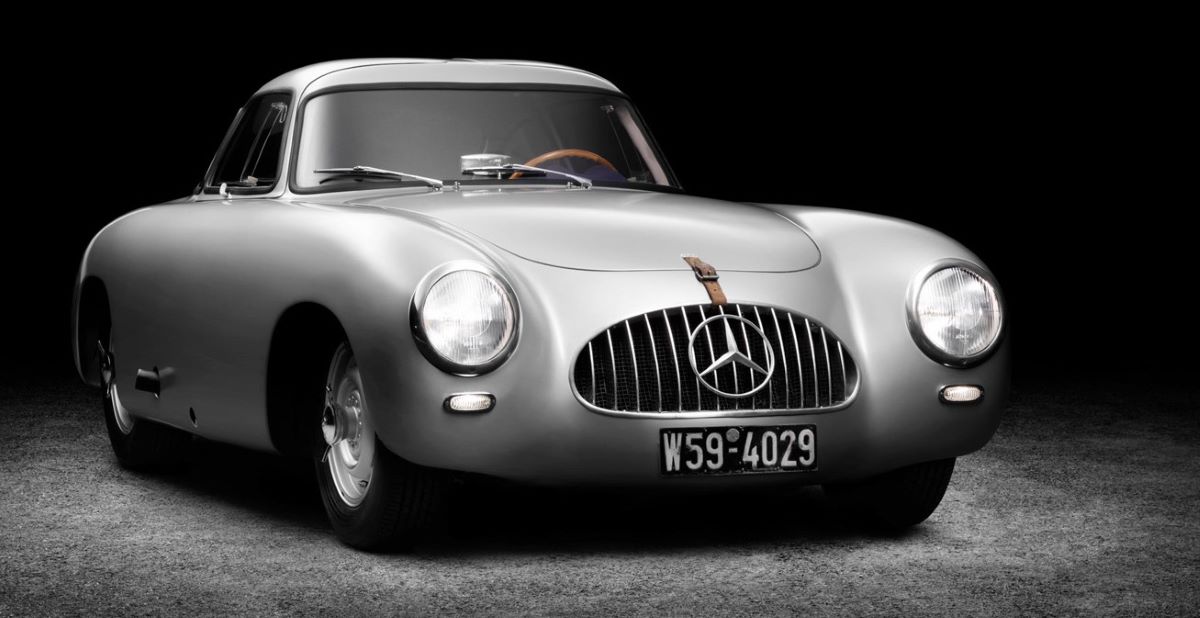


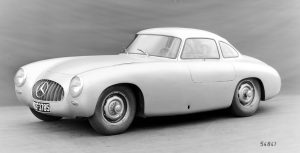
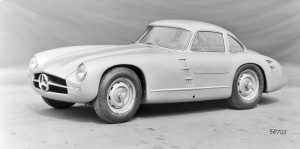
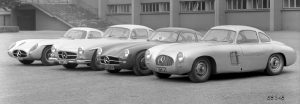
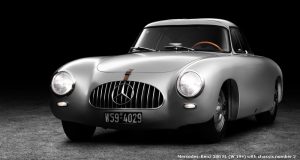

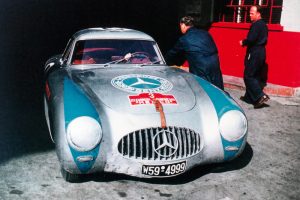
You must be logged in to post a comment.